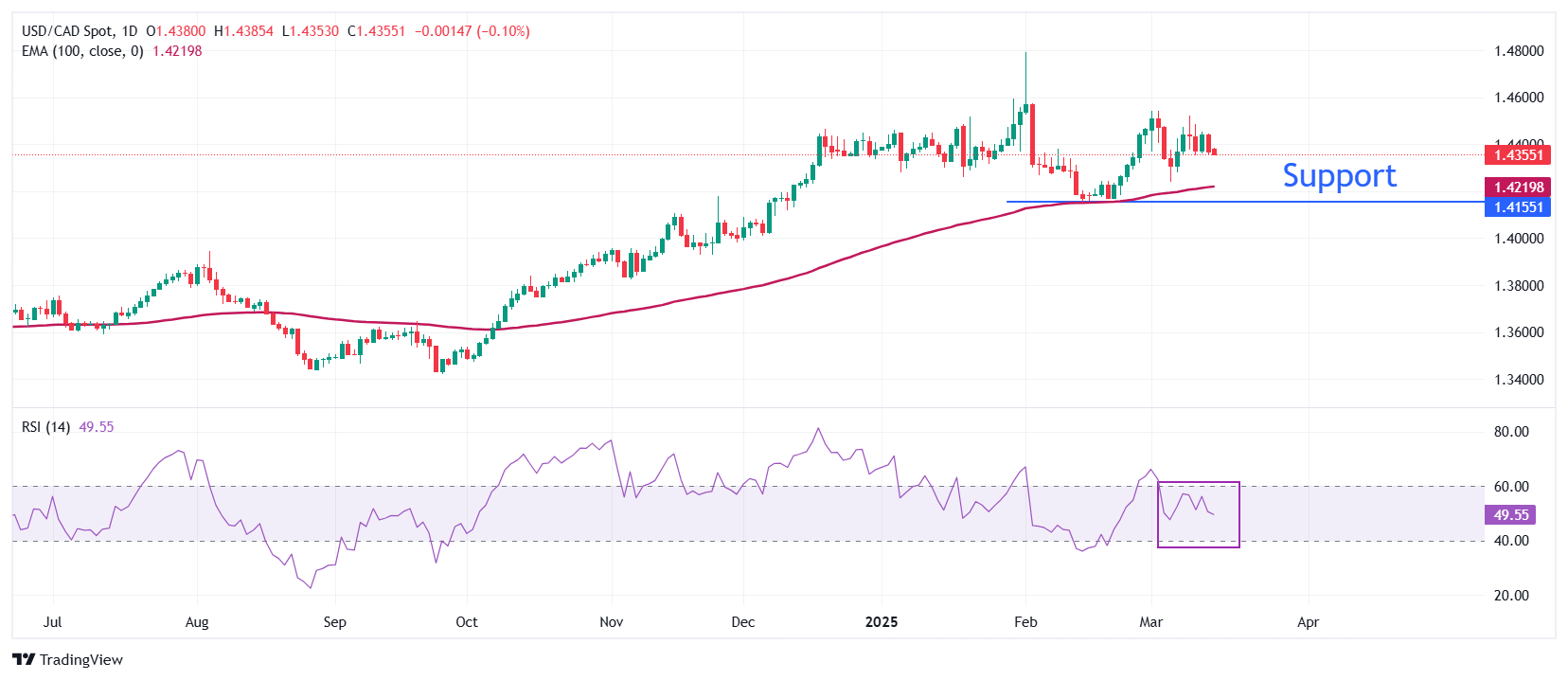USD/CAD Price Forecast: Trades cautiously near 1.4350 as Fed policy takes centre stage
- USD/CAD seems vulnerable near 1.4350 as the US Dollar trades lower ahead of Fed’s policy on Wednesday.
- The Fed is almost certain to keep interest rates steady in the range of 4.25%-4.50%.
- Investors await the US Retail Sales and the Canadian CPI data for February.
The USD/CAD pair struggles to gain ground near the three-day low of 1.4360 in European trading hours on Monday. The Loonie pair trades with caution as the US Dollar (USD) faces selling pressure ahead of the Federal Reserve’s (Fed) monetary policy decision Wednesday. The US Dollar Index (DXY), which tracks the Greenback’s value against six major currencies, trades lower to near 103.55.
Investors expect the Fed to keep interest rates steady in the range of 4.25%-4.50% for the second time in a row. Fed officials have been guiding that borrowing rates should remain at their current levels until they get clarity over new economic policies from US President Donald Trump.
In today’s session, investors will focus on the US Retail Sales data for February, which will be published at 12:30 GMT. Monthly Retail Sales data, a key measure of consumer spending, is estimated to have grown by 0.75 after contracting 0.9% in January.
Meanwhile, the Canadian Dollar (CAD) will be influenced by the Consumer Price Index (CPI) data for February, which will be published on Tuesday. The headline CPI is estimated to have grown by 2.1% in 12 months to February, faster than the 1.9% increase seen in January. An acceleration in price pressures will reduce risks of inflation remaining persistently lower.
USD/CAD holds above the 100-period Exponential Moving Average (EMA), which is around 1.4220, suggesting that the overall trend is bullish.
The 14-period Relative Strength Index (RSI) oscillates in the 40.00-60.00 range, suggesting a sideways trend.
Going forward, an upside move above the March 10 high of 1.4470 will open the door toward the psychological resistance of 1.4500 and the January 30 high of 1.4595.
On the contrary, a breakdown below the February 14 low of 1.4151 by the pair would expose it to the December 9 low of 1.4094, followed by the December 6 low of 1.4020.
USD/CAD daily chart

US Dollar FAQs
The US Dollar (USD) is the official currency of the United States of America, and the ‘de facto’ currency of a significant number of other countries where it is found in circulation alongside local notes. It is the most heavily traded currency in the world, accounting for over 88% of all global foreign exchange turnover, or an average of $6.6 trillion in transactions per day, according to data from 2022. Following the second world war, the USD took over from the British Pound as the world’s reserve currency. For most of its history, the US Dollar was backed by Gold, until the Bretton Woods Agreement in 1971 when the Gold Standard went away.
The most important single factor impacting on the value of the US Dollar is monetary policy, which is shaped by the Federal Reserve (Fed). The Fed has two mandates: to achieve price stability (control inflation) and foster full employment. Its primary tool to achieve these two goals is by adjusting interest rates. When prices are rising too quickly and inflation is above the Fed’s 2% target, the Fed will raise rates, which helps the USD value. When inflation falls below 2% or the Unemployment Rate is too high, the Fed may lower interest rates, which weighs on the Greenback.
In extreme situations, the Federal Reserve can also print more Dollars and enact quantitative easing (QE). QE is the process by which the Fed substantially increases the flow of credit in a stuck financial system. It is a non-standard policy measure used when credit has dried up because banks will not lend to each other (out of the fear of counterparty default). It is a last resort when simply lowering interest rates is unlikely to achieve the necessary result. It was the Fed’s weapon of choice to combat the credit crunch that occurred during the Great Financial Crisis in 2008. It involves the Fed printing more Dollars and using them to buy US government bonds predominantly from financial institutions. QE usually leads to a weaker US Dollar.
Quantitative tightening (QT) is the reverse process whereby the Federal Reserve stops buying bonds from financial institutions and does not reinvest the principal from the bonds it holds maturing in new purchases. It is usually positive for the US Dollar.
